工程管理专业英语
(完整word版)工程管理专业英语徐勇戈课-第二版-后答案
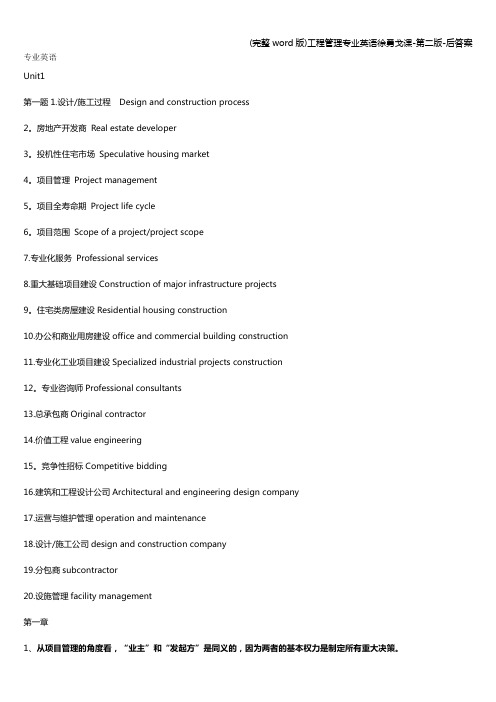
专业英语Unit1第一题1.设计/施工过程Design and construction process2。
房地产开发商Real estate developer3。
投机性住宅市场Speculative housing market4。
项目管理Project management5。
项目全寿命期Project life cycle6。
项目范围Scope of a project/project scope7.专业化服务Professional services8.重大基础项目建设Construction of major infrastructure projects9。
住宅类房屋建设Residential housing construction10.办公和商业用房建设office and commercial building construction11.专业化工业项目建设Specialized industrial projects construction12。
专业咨询师Professional consultants13.总承包商Original contractor14.价值工程value engineering15。
竞争性招标Competitive bidding16.建筑和工程设计公司Architectural and engineering design company17.运营与维护管理operation and maintenance18.设计/施工公司design and construction company19.分包商subcontractor20.设施管理facility management第一章1、从项目管理的角度看,“业主”和“发起方”是同义的,因为两者的基本权力是制定所有重大决策。
2、项目范围界定后,详细的工程设计将提供建设蓝图,最终费用估计将作为控制成本的基准。
工程管理专业英语大纲
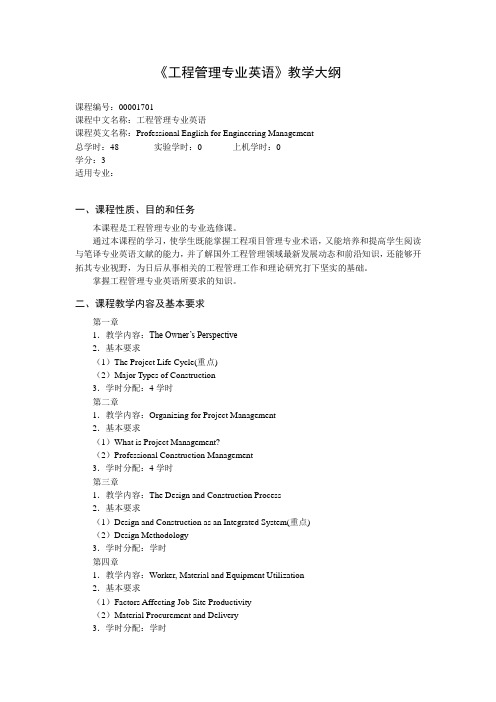
《工程管理专业英语》教学大纲课程编号:00001701课程中文名称:工程管理专业英语课程英文名称:Professional English for Engineering Management总学时:48 实验学时:0 上机学时:0学分:3适用专业:一、课程性质、目的和任务本课程是工程管理专业的专业选修课。
通过本课程的学习,使学生既能掌握工程项目管理专业术语,又能培养和提高学生阅读与笔译专业英语文献的能力,并了解国外工程管理领域最新发展动态和前沿知识,还能够开拓其专业视野,为日后从事相关的工程管理工作和理论研究打下坚实的基础。
掌握工程管理专业英语所要求的知识。
二、课程教学内容及基本要求第一章1.教学内容:The Owner’s Perspective2.基本要求(1)The Project Life Cycle(重点)(2)Major Types of Construction3.学时分配:4学时第二章1.教学内容:Organizing for Project Management2.基本要求(1)What is Project Management?(2)Professional Construction Management3.学时分配:4学时第三章1.教学内容:The Design and Construction Process2.基本要求(1)Design and Construction as an Integrated System(重点)(2)Design Methodology3.学时分配:学时第四章1.教学内容:Worker, Material and Equipment Utilization2.基本要求(1)Factors Affecting Job-Site Productivity(2)Material Procurement and Delivery3.学时分配:学时第五章1.教学内容:Cost Estimation2.基本要求(1)Approaches to Cost Estimation(2)Types of Construction Cost Estimates3.学时分配:学时第六章1.教学内容:Economic Evaluation of Facility Investments2.基本要求(1)Basic Concepts of Economic Evaluation(2)Investment Profit Measures(重点难点)3.学时分配:学时第七章1.教学内容:Financing of Constructed Facilities2.基本要求(1)The Financing Problem(2)Institutional Arrangements for Facility Financing3.学时分配:学时第八章1.教学内容:Construction Pricing and Contracting2.基本要求(1)Pricing for Constructed Facilities(2)Contract Provisions for Risk Allocation3.学时分配:学时第九章1.教学内容:Construction Planning2.基本要求(1)Basic Concepts in the Development of Construction Plans (2)Choice of Technology and Construction Method(重点难点)3.学时分配:学时第十章1.教学内容:Fundamental Scheduling Procedures2.基本要求(1)Relevance of Construction Schedules(2)The Critical Path Method3.学时分配:学时第十一章1.教学内容:Advanced Scheduling Techniques2.基本要求Scheduling with Uncertain Durations3.学时分配:学时第十二章1.教学内容:Cost Control, Monitoring and Accounting2.基本要求The Cost Control Problem3.学时分配:学时第十三章1.教学内容:Quality Control and Safety During Construction2.基本要求Quality and Safety Concerns in Construction3.学时分配:学时第十四章1.教学内容:Organization and Use of Project Information2.基本要求Types of Project Information3.学时分配:2学时三、教材及教学参考书教材:徐勇戈.《工程管理专业英语》.中国建筑工业出版社,2006年.参考书:。
工程管理专业英语词汇
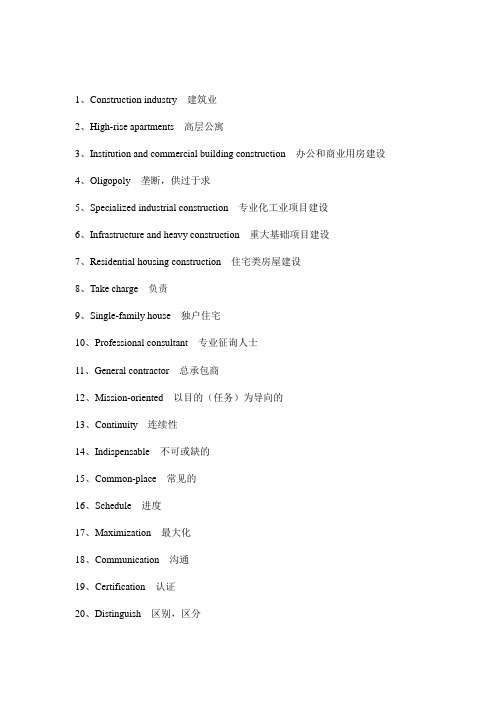
1、Construction industry 建筑业2、High-rise apartments 高层公寓3、Institution and commercial building construction 办公和商业用房建设4、Oligopoly 垄断,供过于求5、Specialized industrial construction 专业化工业项目建设6、Infrastructure and heavy construction 重大基础项目建设7、Residential housing construction 住宅类房屋建设8、Take charge 负责9、Single-family house 独户住宅10、Professional consultant 专业征询人士11、General contractor 总承包商12、Mission-oriented 以目的(任务)为导向的13、Continuity 连续性14、Indispensable 不可或缺的15、Common-place 常见的16、Schedule 进度17、Maximization 最大化18、Communication 沟通19、Certification 认证20、Distinguish 区别,区分21、Predetermined 预定的22、Ingredient 组成部分,成分23、Linear programming 线性规划24、Trade off 均衡,权衡25、Delineation 叙述,说明26、Utilization 使用27、Integration 综合,整合28、Shop drawings 施工图,安装图29、Simultaneously 同时的30、Prebid site 投标前现场31、Nominated subcontractor 指定分包商32、Prequalified 预审合格33、An manual of professional practice 专业人员从业手册34、Risk-reward 风险和回报35、Structural design 结构设计36、Specialized subcontractor 专业分包商37、Work package 工作包38、Construction planning 施工计划39、Technical feasibility 技术可行性40、Construction operations 施工作业41、Structural or foundation details 结构或基础的具体情况42、Ingenuity and creativity 灵活性和发明性43、Construction constractors 施工承包商44、Monitoring and control 监督和控制45、Facility design 设施设计46、Estimate stage 估算阶段47、Evaluation stage 评估阶段48、equity partners 股权伙伴49. 、specifications and drawings 技术规范和图纸50.、Placing concrete on site 现场浇混凝土1、Job-site productivity 工地生产率2、Contractual agreements 协议3、Safety consciousness 安全意识4、Labor productivity 劳动生产率5、Foreign operations 国外施工6、Labor efficiency 劳动效率7、Infrastructure 基础设施8、Linear interpolation 线性内插9、Labor jurisdictions 劳动仲裁10、Non-productive activities 非生产性活动11、On-site 现场12、Labor characteristics 劳动力的特性13、Security sensitivity 安全敏感性14、Recognized strength 公认的实力15、Processing plant 加工厂16、Logistic problems 后勤问题17、Drilling platform 钻井平台18、Building construction 建筑施工19、Material procurement and delivery 材料采购和运送20、Bulk materials 大宗材料21、Overlapping and rehandling 搭接和再解决22、Semi-processed 半加工的,半成品的23、Concrete mix 混凝土拌和物24、Steel beams and columns 钢梁和柱25、. bills of quantity 工程量清单26、. minutes of the conference 会议纪要27、the lowest evaluated cost 经评审的最低造价28、reimbursable expenses 可补偿费用29、.Hierarchical structure 层级结构30、Critical path scheduling 关键线路进度控制程序31、.bonus and penalty clauses 奖励和处罚条款32、lump-sum agreement 总价协议33、.written authorization 书面授权34、unit-price agreement 单价协议35、Bids and quotations 投标和报价36、Off-the-shelf material 现货材料37、Earthwork to be excavated 土方开挖38 .general procurement notice 通用采购公告39、. conditions of contract 协议条件40、Construction supervision 施工监督41、Freight delivery 货品运送44、Slippage or contraction 延误或提前45、.Marginal efficiency of capital 边际资本收益46、.Equivalent uniform annunual net value 等额净年值47、changes clause 变更条款49、prequalification 资格预审49、limited international bidd ing 有限国际招标50、Unit Cost of Estimetion 单位估价1、Cost estimation 成本估算2、Cost engineering 工程估价3、Profitability 赢利4、Production function 生产函数5、Statistical inference 记录推断6、Construction equipment 施工机具7、General office overhead 总部管理费8、The cost engineer or estimator 估算师9、Cost control 成本控制10、Empirical cost inference 经验成本推论法11、Allocation of joint costs 综合成本的分摊12、Bill of quantities 工程量清单2、Cooling system 冷却系统3、Heat exchanger 热互换器4、Slabs and beams 楼板和梁5、Furnaces 锅炉6、Plus ancillary items 辅助设备7、Formwork 模板8、Detailed Estimates 具体估算9、Preliminary Estimates 具体估算10、Subcontractor Quotations 分包报价11、Construction Procedures 施工方法12、Factored Estimate Formula 系数估算公式13、Reinforcing bars 钢筋14、Building foundation 建筑物基础1、Economic evaluation 经济评价2、Sensitivity 灵敏度3、Planning horizon 规划周期4、Project alternative 备择项目5、Opportunity cost 机会成本6、Financial investment 金融投资7、Minium attractive rate of return 最低收益率8、Social rate discount 社会折现率9、Investment consideration 投资分析10、Decision maker 决策者11、Cash flow profile 钞票流分布形态12、Net annual cash flow 年净钞票流13、Capital project 资本项目14、Socially desirable programs 社会公益项目15、The Office of Management and Budget 财政部门16、Government agency 政府部门17、linear programming线性规划18、network analysis 网络分析19、Under ordinary circumstances, 在通常情况下20、best price/performance characteristics最优性价比特性21、an acceptable quality levelallowable可接受的质量水平22、a allowable fraction of defective items.可接受的缺陷比例23、ill structured棘手的24、critical ingredients关键因素25、identified as被看作为26、the rate of return资本回收率 cash flow 净钞票流量28.financing options 融资方式29.project finance 项目融资30.negative cash balance 负钞票结余31.profit measure 利润指标值32.private corporations 私营股份制公司33.Public agencies 公告机构34 instructions to bidders 投标人须知35 . conditions of contract协议条件36.Equivalent uniform annunual net value 等额净年值37.Capital recovory factor 资金回收因子38.Benefit cost ratio 收益费用比39.Profitability index 赚钱指数40. prequalification 资格预审41. bidding documents 招标文献42. domestic contractor 国内承包商43.Marginal efficiency of capital 边际资本收益44.Adjusted internal rate of capital 调整后的内部收益率45.Return on investment 投资收益46. international competitive bidd ing 竞争性国际招标47limited international bidd ing 有限国际招标48.national competitive bidd ing 国内竞争性招标49 .general procurement notice 通用采购公告50 substantially responsive 实质性响应1. changes 工程变更2. contract awards 协议授予3.changes clause 变更条款4.publicly financed priject 公共项目融资5.extra work 附加工作6.the prime contractor 主承包商7. pre-construction sercices 施工前服务8.reimbursable expenses 可补偿费用9. overhead and profit 管理费和利润10.Construction planning 施工计划11. chioce of technology 施工技术的选择12.The definition of work tasks 工作任务的定义13.Normative problem 规范性问题14.Cost control 成本控制15.Schedule control 进度控制16.Critical path scheduling procedure关键线路进度控制程序17.Job shop scheduling procedure 工作现场进度控制程序18.Datebases and information systes m 数据库和信息系统19.The duration of the activity 工作活动的连续时间20.Placing concrete on site 现场浇筑混凝土21 Placing forms 支设模版22. Installing reinforcing steel 绑扎钢筋23. Pouring concrete 浇筑混凝土24.Finishing the concrete 混凝土养护25. Removing forms 模版拆除26.Position forms on the cleanning station 在清理场合码放模版27. Hierarchical structure 层级结构28.fixed fee 固定费用29.overhead and profit 管理费和利润30.job shop scheduling procedure 现场进度控制程序31.change order 变更单32.cost –plus-fee agreement成本加费用协议33.quantity takeoff 工程量清单34. prequalification 资格预审35、decomposed into 分解为36.From the viewpoint of从某个角度看37.responsible for 对某事负责38.superior to 优于。
工程管理专业英语单词

பைடு நூலகம்
工程管理专业英语试题(含答案)
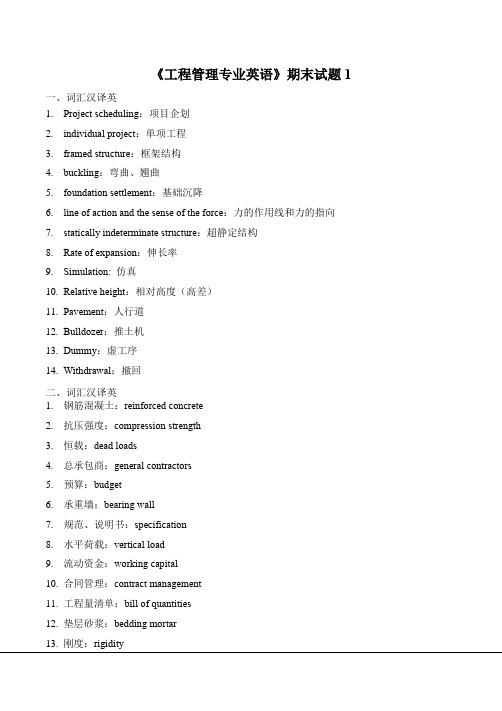
《工程管理专业英语》期末试题1一、词汇汉译英1.Project scheduling:项目企划2.individual project:单项工程3.framed structure:框架结构4.buckling:弯曲、翘曲5.foundation settlement:基础沉降6.line of action and the sense of the force:力的作用线和力的指向7.statically indeterminate structure:超静定结构8.Rate of expansion:伸长率9.Simulation: 仿真10.Relative height:相对高度(高差)11.Pavement:人行道12.Bulldozer:推土机13.Dummy:虚工序14.Withdrawal:撤回二、词汇汉译英1.钢筋混凝土:reinforced concrete2.抗压强度:compression strength3.恒载:dead loads4.总承包商:general contractors5.预算:budget6.承重墙:bearing wall7.规范、说明书:specification8.水平荷载:vertical load9.流动资金:working capital10.合同管理:contract management11.工程量清单:bill of quantities12.垫层砂浆:bedding mortar13.刚度:rigidity三、典型句子英译汉1、All these loads depend largely on the location of the building, have to be taken by the structural system from all points and manners of application and transferred to the foundations.所有这些荷载,在很大程度上取决于建筑物的位置,这些荷载由结构体系从各个点以各种作用方式传递到基础。
(完整word版)工程管理专业英语词汇
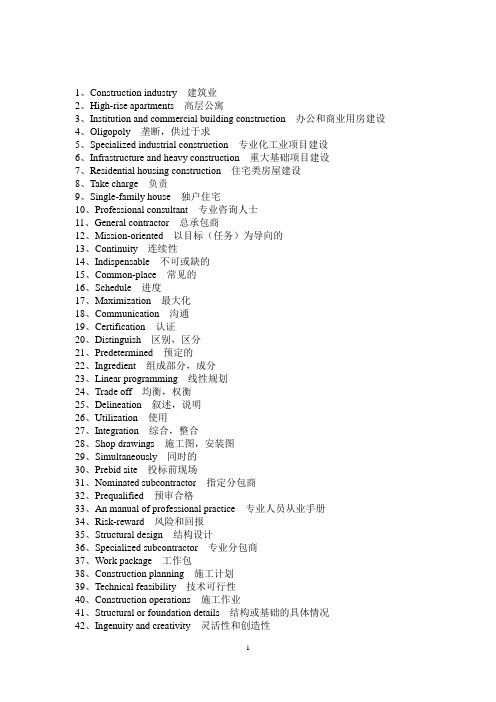
1、Construction industry 建筑业2、High-rise apartments 高层公寓3、Institution and commercial building construction 办公和商业用房建设4、Oligopoly 垄断,供过于求5、Specialized industrial construction 专业化工业项目建设6、Infrastructure and heavy construction 重大基础项目建设7、Residential housing construction 住宅类房屋建设8、Take charge 负责9、Single-family house 独户住宅10、Professional consultant 专业咨询人士11、General contractor 总承包商12、Mission-oriented 以目标(任务)为导向的13、Continuity 连续性14、Indispensable 不可或缺的15、Common-place 常见的16、Schedule 进度17、Maximization 最大化18、Communication 沟通19、Certification 认证20、Distinguish 区别,区分21、Predetermined 预定的22、Ingredient 组成部分,成分23、Linear programming 线性规划24、Trade off 均衡,权衡25、Delineation 叙述,说明26、Utilization 使用27、Integration 综合,整合28、Shop drawings 施工图,安装图29、Simultaneously 同时的30、Prebid site 投标前现场31、Nominated subcontractor 指定分包商32、Prequalified 预审合格33、An manual of professional practice 专业人员从业手册34、Risk-reward 风险和回报35、Structural design 结构设计36、Specialized subcontractor 专业分包商37、Work package 工作包38、Construction planning 施工计划39、Technical feasibility 技术可行性40、Construction operations 施工作业41、Structural or foundation details 结构或基础的具体情况42、Ingenuity and creativity 灵活性和创造性43、Construction constractors 施工承包商44、Monitoring and control 监督和控制45、Facility design 设施设计46、Estimate stage 估算阶段47、Evaluation stage 评估阶段48、equity partners 股权伙伴49. 、specifications and drawings 技术规范和图纸50.、Placing concrete on site 现场浇混凝土1、Job-site productivity 工地生产率2、Contractual agreements 合同3、Safety consciousness 安全意识4、Labor productivity 劳动生产率5、Foreign operations 国外施工6、Labor efficiency 劳动效率7、Infrastructure 基础设施8、Linear interpolation 线性内插9、Labor jurisdictions 劳动仲裁10、Non-productive activities 非生产性活动11、On-site 现场12、Labor characteristics 劳动力的特征13、Security sensitivity 安全敏感性14、Recognized strength 公认的实力15、Processing plant 加工厂16、Logistic problems 后勤问题17、Drilling platform 钻井平台18、Building construction 建筑施工19、Material procurement and delivery 材料采购和运输20、Bulk materials 大宗材料21、Overlapping and rehandling 搭接和再处理22、Semi-processed 半加工的,半成品的23、Concrete mix 混凝土拌和物24、Steel beams and columns 钢梁和柱25、. bills of quantity 工程量清单26、. minutes of the conference 会议纪要27、the lowest evaluated cost 经评审的最低造价28、reimbursable expenses 可补偿费用29、.Hierarchical structure 层级结构30、Critical path scheduling 关键线路进度控制程序31、.bonus and penalty clauses 奖励和惩罚条款32、lump-sum agreement 总价合同33、.written authorization 书面授权34、unit-price agreement 单价合同35、Bids and quotations 投标和报价36、Off-the-shelf material 现货材料37、Earthwork to be excavated 土方开挖38 .general procurement notice 通用采购公告39、. conditions of contract 合同条件40、Construction supervision 施工监督41、Freight delivery 货物运输44、Slippage or contraction 延误或提前45、.Marginal efficiency of capital 边际资本收益46、.Equivalent uniform annunual net value 等额净年值47、changes clause 变更条款49、prequalification 资格预审49、limited international bidd ing 有限国际招标50、Unit Cost of Estimetion 单位估价1、Cost estimation 成本估算2、Cost engineering 工程估价3、Profitability 赢利4、Production function 生产函数5、Statistical inference 统计推断6、Construction equipment 施工机具7、General office overhead 总部管理费8、The cost engineer or estimator 估算师9、Cost control 成本控制10、Empirical cost inference 经验成本推论法11、Allocation of joint costs 综合成本的分摊12、Bill of quantities 工程量清单2、Cooling system 冷却系统3、Heat exchanger 热交换器4、Slabs and beams 楼板和梁5、Furnaces 锅炉6、Plus ancillary items 辅助设备7、Formwork 模板8、Detailed Estimates 详细估算9、Preliminary Estimates 详细估算10、Subcontractor Quotations 分包报价11、Construction Procedures 施工方法12、Factored Estimate Formula 系数估算公式13、Reinforcing bars 钢筋14、Building foundation 建筑物基础1、Economic evaluation 经济评价2、Sensitivity 灵敏度3、Planning horizon 规划周期4、Project alternative 备择项目5、Opportunity cost 机会成本6、Financial investment 金融投资7、Minium attractive rate of return 最低收益率8、Social rate discount 社会折现率9、Investment consideration 投资分析10、Decision maker 决策者11、Cash flow profile 现金流分布形态12、Net annual cash flow 年净现金流13、Capital project 资本项目14、Socially desirable programs 社会公益项目15、The Office of Management and Budget 财政部门16、Government agency 政府部门17、linear programming线性规划18、network analysis 网络分析19、Under ordinary circumstances, 在通常情况下20、best price/performance characteristics最优性价比特征21、an acceptable quality levelallowable可接受的质量水平22、a allowable fraction of defective items.可接受的缺陷比例23、ill structured棘手的24、critical ingredients关键因素25、identified as被看作为26、the rate of return资本回收率 cash flow 净现金流量28.financing options 融资方式29.project finance 项目融资30.negative cash balance 负现金结余31.profit measure 利润指标值32.private corporations 私营股份制公司33.Public agencies 公告机构34 instructions to bidders 投标人须知35 . conditions of contract合同条件36.Equivalent uniform annunual net value 等额净年值37.Capital recovory factor 资金回收因子38.Benefit cost ratio 收益费用比39.Profitability index 盈利指数40. prequalification 资格预审41. bidding documents 招标文件42. domestic contractor 国内承包商43.Marginal efficiency of capital 边际资本收益44.Adjusted internal rate of capital 调整后的内部收益率45.Return on investment 投资收益46. international competitive bidd ing 竞争性国际招标47limited international bidd ing 有限国际招标48.national competitive bidd ing 国内竞争性招标49 .general procurement notice 通用采购公告50 substantially responsive 实质性响应1. changes 工程变更2. contract awards 合同授予3.changes clause 变更条款4.publicly financed priject 公共项目融资5.extra work 附加工作6.the prime contractor 主承包商7. pre-construction sercices 施工前服务8.reimbursable expenses 可补偿费用9. overhead and profit 管理费和利润10.Construction planning 施工计划11. chioce of technology 施工技术的选择12.The definition of work tasks 工作任务的定义13.Normative problem 规范性问题14.Cost control 成本控制15.Schedule control 进度控制16.Critical path scheduling procedure关键线路进度控制程序17.Job shop scheduling procedure 工作现场进度控制程序18.Datebases and information systes m 数据库和信息系统19.The duration of the activity 工作活动的持续时间20.Placing concrete on site 现场浇筑混凝土21 Placing forms 支设模版22. Installing reinforcing steel 绑扎钢筋23. Pouring concrete 浇筑混凝土24.Finishing the concrete 混凝土养护25. Removing forms 模版拆除26.Position forms on the cleanning station 在清理场所码放模版27. Hierarchical structure 层级结构28.fixed fee 固定费用29.overhead and profit 管理费和利润30.job shop scheduling procedure 现场进度控制程序31.change order 变更单32.cost –plus-fee agreement成本加费用合同33.quantity takeoff 工程量清单34. prequalification 资格预审35、decomposed into 分解为36.From the viewpoint of从某个角度看37.responsible for 对某事负责38.superior to 优于。
工程管理专业英语(英文版)一、建设项目的主要类型

The residential housing market is heavily affected by general economic conditions, tax laws, and the monetary and fiscal policies of the government. Often, a slight increase in total demand will cause a substantial investment in construction, since many housing projects can be started at different locations by different individuals and developers at the same time. Because of the relative ease of entry, at least at the lower end of the market, many new builders are attracted to the residential housing construction. Hence, this market is highly competitive, with potentially high risks as well as high rewards.
批注本地保存成功开通会员云端永久保存去开通
Unit one Major Types of Construction
Since most owners are generally interested in acquiring only a specific type of constructed facility, they should be aware of the common industrial practices for the type of construction pertinent to them. Likewise, the construction industry is a conglomeration of quite diverse segments and products. Some owners may procure a constructed facility only once in a long while and tend to look for short term advantages.
工程管理专业英语

Aagents:代理(商)6additional facilities outside the site:现场以外的附加设施6access routes:进场通路6a lump sum contract:总价合同7a low bidder:低价投标人7a unit price contract:单价合同7award procedures:授予程序8a cost plus fixed percentage contract:成本加固定百分比费用合同7a cost plus fixed fee contract:成本加固定费用合同7a cost plus variable percentage contract:成本加变动比例费用合同7a target estimate contract:目标估算合同7a guaranteed maximum cost contract:保证最大成本合同7a summary budget:汇总预算4an alternative tender:含替代方案的投标书9 a bonus in relation to early completion:提前完工奖金9acceptance of tender:中标9a letter of acceptance:中标函9award of the Contract:授予合同9appendix to tender:投标书附录9an assignment of:……提供的担保10 assignment of interest:保险权益转让10a network plan:网络计划11an activity-on-branch network:双代号网络计划图11an activity-on-node network:单代号网络计划图11a linear programming problem:线性规划问题11 an activity-on-branch network:有分支的网络计划11actual finish times:实际完成时间12a general contractor:总承包商 1accuracy of cost estimates:估价精度 3an architectural/engineering firm:建筑/设计公司 1an extension of time:延长期 2 authorization:授权 1a bonus provision:奖励条款 13 a penalty provision:惩罚条款13additional payment:追加付款 15a final claim:最终的索赔报告 15an amicable settlement:友好解决15arbitral award:仲裁裁决;公断书15 assignee:受让人 16amount of guarantee:担保金额16 administrator:管理人员 16Bbill of quantities:工程量表8base date:基准日期6backward pass:逆向过程11baseline plan:基准计划12bid estimate:投标估价 3bill of quantities:工程量清单 3budget estimate:财务预算 3by these presents:[律]根据本文件16bonding company:担保公司16balance of the contract price:合同价格余额 16 Ccost to date:完工成本5cost committed:承诺成本5cost exposure:附加成本5cost ratio:成本率5contractor’s representative:承包商代表6 contract price:合同价格6contractor’s equipment:承包商设备6 contractor’s operations on site:承包商的现场作业6construction contract:工程承包合同7 comparative advantages:相对优势;比较优势7 competitive tendering:竞争性招标8 conditions of contract:合同条件8contract documents:合同文件8contract number:合同编号8cost control:成本控制4cash flow:现金流量4contingency allowance:应急准备金4currency requirements:货币要求9contract agreement:合同协议9Construction Contractor:建筑承包商10 completion bonds:完工担保10 Comprehensive General Liability:公众责任险10constraints:约束条件11critical activities:关键工序11 commencement date:开工日期 2construction cost:施工建设费 3 construction division:施工部门 1 construction management:施工管理 1 construction schemes:施工计划;施工安排 1 contract price:合同价格 2control estimate:控制估价 3cost center:成本中心 1cost control:成本控制 3cost engineering:工程估价 3cost engineers:造价工程师 3cost estimation:成本估算 3completed activities:已完成13claim:索赔15corrective action:纠正措施13contemporary record:同期记录15Ddecision making:决策7drawings:图纸8database:数据库4direct labor costs:直接人工成本4duration of the critical path:关键路径的持续时间11data on actual performance:实际执行中的数据12debt service coverage ratios:利息保障率10 dummy activities:虚工作11debt service:还本付息;偿债 1decision-making:决策 1defects notification period:缺陷通知期限 2 delegated persons:受托人员 2design and construction alternatives:设计或施工的替代方案 1design estimate:设计估价 3designer-constructor sequence:设计施工顺序模式 1detailed estimates (or definitive estimates):详细估计(或确定估计) 3direct construction cost:直接施工成本 3 dispute:争端 2database:数据库 13additional payment:追加付款 15 dissatisfaction:不满;不平15dispute adjudication agreement:争端裁决协议15dispute adjudication board:争端裁决委员会15 discharge from:释放;使免除15disputes:争端15Eestimated total cost for completion:预计完工总成本5expiry date:有效期限;满期日;终止日期6 exogenous economic factors:外部经济因素7 employer’s equipment:雇主设备6exchange rates:汇率9evaluation of tenders:评标9earliest event time algorithm:节点最早时间算法11event (or node)numbering algorithm:按节点编号算法11empirical cost inference:经验成本推论 3 employer:雇主;业主 2employer’s representative:雇主代表 2 engineering division:工程设计部门 1 errors, omissions, or discrepancies:错误,遗漏或误差 2expected benefits:期望收益 14executor:执行者;被指定遗嘱执行者 16 economy of scale:因经营规模扩大而得到的经济节14economic feasibility:经济可行性 14Ffinancial accounting:财务计算;财务会计5 forecasting for activity cost:工作成本预测5 field observations:现场观察5free-issue material:免费供应材料6financial performance:财务状况4financial bills:财务单据4formal addenda:正式补遗9feedstock supplier:原材料供应商10 feasibility study:可行性研究10file tax returns:报送纳税申报单位10 financial projections:财务预算10Financial Covenants:财务承诺10fixed duration:固定持续时间11forward pass:顺向过程11feasibility study of a project:项目可行性研究 1field inspectors:现场检查员 1field observers:现场观察员 1field supervision of construction:现场施工监督 3financial arrangements:资金安排 2financial costs:财务成本 3free-issue material:免费供应材料 2field experience:现场经验 14financial institution:金融机构16Ggeneral partnerships:普通合伙公司10 graphical network:图解网络计划11general provisions:一般条款10Gantt chart:甘特图 13green building:绿色建筑14guarantee:保证;保证书;担保;抵押品16Hhomebuilder:住宅开发商 14heir:继承者;承袭者 16Iincremental milestones:里程碑累计5 instructions to tenderers:投标者须知;投标者指令8inflation allowance:通货膨胀准备金4 indirect costs:间接成本4intellectual property:知识产权10 independent inspectors:独立检查员 2initial capital:创办成本;初始投资 3 integration of organizations:集约型组织 1 information system:信息系统13innovation:创新 14innovative design:创新性设计 14invoice:发票;发货单15international arbitration:国际仲裁15 interim payment:期中付款15insurance company:保险公司 16Jjob status report:工作状况报告5job specifications:施工(工作)规范4job cost elements:工作成本要素4joint costs:联合成本 3L local laws or decrees:当地法律或法令9 leverage:杠杆作用10limited recourse:有限追索权10lender:贷款人10liquidated damages:违约赔偿金10latest event time algorithm:节点最晚时间算法11land acquisition:土地获得 3land rent:土地租金 3liability during construction:建设期债务 1 laborhour:工时 14legal representative:法定代表 16Mmaterial change to financial arrangements:重要的财务变更 2matrix organization:矩阵式组织形式 1 monthly payments:月度付款 1material suppliers:材料供应商 14Nnegotiate:谈判;协商6nominated subcontractor:指定的分包商6non-recourse:无追索权10nodes in a network:网络节点11network structure:网络结构11network-based planning:基于网络的计划 13 negative slack:负时差13Ooriginal tender:投标书正本8official offer:正式报价8optimum markup:最优增加值7overruns:超支4overhead and contingency amounts:企业管理费用和应急费用总计4off-balance-sheet treatment:资产负债表外处理10owning cost:占有成本10on a regular basis:定期地10on-going projects:在建项目 1operation and maintenance costs:运行与养护费用 3operations division:运营部门 1outside contractors:外部承包商 1 overhead:企业一般管理费用 3owner-builder operation:业主自行建造项目 1obligee:债权人;权益人16obligation:义务;债务 16Pproject control:项目控制5performance security:履约担保6 permission:许可6protection of the environment:环境保护6 progress reports:进度报告6potential competitors:潜在的竞争者7 prequalification:资格预审8permanent works:永久性工程8period of validity of tenders:投标书的有效期8project budget:项目预算4provisional sums:暂定金额9project financing:项目融资10project operator:项目运营商10product offtaker:产品承购商10put-or-pay:或供或付协议10project performance:项目绩效10 performance bonds:履约担保10precedence relationships:前后顺序关系11 precedence constraint:优先限制11 predecessor activities:紧前工作11 precedence of a finish-to-start nature:结束-开始型顺序11project control process:项目控制过程12 project scope:项目范围12project team:项目团队12project changes:项目变更12Parallel processing:并行处理;多重处理 1 performance security:履约担保 2 performance specifications:设计任务说明书;规范(规格说明书) 1periodic renovations:周期性更新 3 permits, licences or approvals:许可、执照或批准 2possession of the site:占用现场 2 preliminary estimates (or conceptual estimates):初步估算(或概念性估算) 3 procurement of material and equipment:材料和设备的采购 1production cost:生产成本 3production function:产出函数 3 profits:利润 3project cost and schedule:项目的成本和进度 1 project life cycle:项目生命周期 3project manager:项目经理 1project participants:项目参与方1project team:项目团队 1project-oriented organization:以项目为导向的组织 1protection of the environment:环境保护 2 preliminary review:初步评13positive slack:正时差 13productivity:生产率 13project size:项目规模 14project location:项目所在地14 prefabrication:配件预先制造 14principal:委托人;当事人16penalty:处罚;罚款 16Qquality assurance system:质量保证体系6 quality of construction:建筑质量 1Rrights-of-way:道路通行权6receipt:回执;收据9resource constraint:资源限制11reporting period:报告期12resident engineer:驻地工程师 2right of access to the site:进入现场的权利 2 residential housing:住宅建筑 14Rules of Arbitration of the International Chamber of Commerce:国际商会仲裁规则remain in force:在有效期中,仍然有效16Ssunk cost:沉没成本;已支付成本5set out:放线6safety procedures:安全程序6 subcontractor:分包商6site data:现场数据6specification:规范;详述;说明书8 standards of workmanship:工艺标准8 supplementary information:补充信息8 security of the site:现场保安6 supplementary drawings:补充图纸8separate accounts:专账4site visits:现场考察9signatories:签署人9sponsor:发起方10successor activities:紧后工作11screening estimates(or order of magnitude estimates):筛选估计;匡算(或数量级估计) 3 Separation of organizations:独立型组织 1 sequential processing:串行处理;顺序加工 1 shop drawings of fabrication:车间安装图 1 site:现场 2specialty subcontractors:专业分包商 1 staggered processing:交叉处理;错列处理 1 subcontract:分包合同 1supervise:监理 1strategic decisions:战略决策 14software packages:软件包13supplier:供应商 13schedule control:进度控制13surety:保证人;担保人16successor:接任者 16Ttender:招标;投标8temporary works:临时工程6taking-over certificate:接收证书6transport of goods:货物运输6tender reference number:投票参考编号8 tender bond:投标保函;投标保证金8tender submission date:投标书提交日期9 traditional financing:传统融资10tax benefits:税收优惠10take-or-pay contract:照付不议合同10the critical path method (CPM):关键路径法11 the longest possible path:最长可能路径11 the earliest starting time:最早开始时间11 the latest starting time:最晚开始时间11 the latest finishing time:最晚结束时间11 the earliest finishing time:最早结束时间11 total slack:总时差12the amount or volume of output:产出总量 3 the employer’s requirements:雇主要求 2 time for completion:竣工时间 2turnkey operation:交钥匙项目 1the period of bid validity:投标有效期16 technological feasibility:技术可行性 14 technology required:技术要求 14tactical decisions:战术决策 14time for completion:竣工时间15top priority:最高优先级 13Uunexpected costs:不可预见费用 3unit cost:单位成本 3units of work completed:完工劳动单元5 unbalanced bid:不平衡报价7unforeseen events:不可预见事件4Vvariances:偏差;不一致12variation:变更;变化6Wwork elements:作业要素4wholly owned subsidiary:完全控股子公司10 witness:证人;作证16written demand:书面要求16。
工程管理专业英语

make good use of -> utilize,
数量的翻译
小数,分数,百分数
0.1: zero point one, point one, o point one, one tenth,
0.01: point zero one, 10.35: ten point three five 1/2: a (one) half 1/3: a third 1/4: one quarter 2/3: two-thirds, 3/4: three-fourths, three quarters 3%: three percent 0.2% : point two percent 5‰: five per mill
例6、The total weight being less, it is possible to build much taller building.
(4)长句虽多,但句型简单。 注:例8中 member 译为 构件
(5)省略句较多。
省略成分:状语从句中的主语、全部或部分谓语;定语从句 中的关系代词which和that、从句中的助词等;还常用介词短 语替代从句。
Professional English for Engineering Management
工程管理专业英语
Unit 1
பைடு நூலகம்
专业英语翻译
工程管理翻译为construction management,是指 在一定的约束条件下,以最优地实现工程项目为目 的,按照其内在的逻辑规律对工程项目进行有效的 计划、组织、协调指挥、控制的系统管理活动。 工程管理需要的知识、技能和工具与技术非常广 泛,有技术、管理、法律、金融、财务等各个方 面,涉及到工程的进度、费用、质量、风险、人 力资源、沟通与交流、采购与合同等。
工程管理专业英语unit2

Unit 2 Emerging Role of Management in Civil Engineering 管理对土木工程的重要性
When local firms insist that they only participate as a join-venture
桂林理工大学博文管理学院建筑工程系 工程管理专业英语
Unit 2 Emerging Role of Management in Civil Engineering 管理对土木工程的重要性
Comprehension Exercises
Please answer the following questions briefly. Q1:what is the basis for the argument that the need for civil engineering is growing? Q2: what is the hottest new graduate program in civil engineering at northwestern university? which subjects does the program include? Q3 why are all project managers required to be able to communicate well verbally as well as in writing?
在当地公司坚持它们只能以合资伙伴参与,项目经理面临的问题
就增加了,因为当地公司通常不能提供一份履约保证金、责任保 险或者甚至是一套有意义的能建立它们真正的工资成本和日常开 支的账户。 In summary, the present paper is intended to show……总之,本文 旨在说明…… accelerate vt. 加速,促进,增加 command vt. 赢得,拥有,掌握 appreciably ad.明显的,可觉察到,相当的
工程管理专业英语词汇

工程管理专业英语词汇A Cash flow profile现金流量图Credit risk信用风险 As-built drawings竣工图Competitive biddingAnnual net value净年值公开招标 Arbitration仲裁A dashed line虚Contract price合同价格线 Clause条款Activity-on-branch network双代号网络Contract negotiation合同谈判图Contract dispute合同纠纷 Activity-on-node network单代号网络Cost overrun成本超支图 Cost committed承诺成本Cost to date到期成本 A vertical axis纵坐标Archival information档案资料 Cost exposure附加成本Critical path method关键线路法Construction yard施工现场 BBottom-up design自下而上的设计Bids and quotations投标和报价 DBill of quantities工程量清单 detailed engineering design详细的工程设计 Bid estimate 投标估价design methodology设计方法 Benefit cost ratio成本收益率Budgeted cost预算成本 detailed design详细设计drilling and blasting钻孔和爆破detailed estimates详细估算 CConceptual planning stage概念规划阶dispute resolution mechanism争端解决段机制Capital intensive资金密集的 design drawing设计图纸 Competitive bidding竞争性招/投标 dummy activities虚工作 Contract price合同价格claims索document control文档控制赔Constructors建造商 Echanges变更 clause条款 Economic feasibility经济可行性 Conceptual design概念设计 Estimate stage估算阶段 construction operations施工作业evaluation stage评估阶段 Construction contractor施工承包商 equipment utilization and mechanizationConstruction equipment施工设备设备利用率和机械化 Concrete mixers混凝土搅拌机 earthwork to be excavated土方开挖 Cost estimation成本估算Economic evaluation经济评价 Cost control成本控制 Expenditure支出Cost Engineering工程估价 Excavation开掘Construction supervision施工监督 Estimated total cost预计总成本Construction cost建造成本Control estimate控制估算 FConceptual estimate概念设计估算 Feasibility study可行性研究Construction procedures施工方法 Facility operation and maintenance设施Cost indices成本指数的运营与维护 formulation构思 Consumer price index 消费价格指数 Facilities management设施管理 line" chapter, and signature confirmation. Article 17th account manager by the people's bank credit system query print credit report to verify the credit histories and guaranty to the parties. No credit report or credit score, through field surveys or other means to implement the credit situation and external security situation, according to riskFunctional organization职能式组织 Matrix-type suborganization矩阵式次First line supervision基层监督级组织Field management现场管理 Monitoring and control监督与控制 Force-account charges自营工程费 Material procurement and delivery材料Free float自由时差采购和运输Fast track快速路径法 Mortgage抵押 Milestone里程碑 Final checkout最终的竣工验收 Municipal project市政项目 G Monte carlo simulation蒙特卡罗模拟 Gantt chart甘特图NH Horizontal axis水平坐标 Nominated subcontractor指定分包商Non-productive activities非生产性活动 I Net annual cash flow年净现金流 Integrate整合 Net benefit净收益 Negotiation谈Instruction and commercial building 判construction 办公和商业用房建设 Net present value净现值Infrastructure and heavy construction重Net future value净终值大基础项目建设 Numerous alternative plans众多的备选Installation contractors安装承包商方案Ill-defined定义不清的 Network diagrams网络计划图 Inflation通货膨胀Internal rate of return内部收益率 OIntangible asset无形资产 Overlap 搭接,交叠 on-site现场 Interest rate利率 Operation and maintenance managers运In-house overhead expenses内业管理费行与维护经理Independent float独立时差 On-site Installation现场安装 Inspection logs检查日志 Overseer监督者 Overdraft透支 Information transfer andflow信息的传Overlapping and rehandling搭接和再处递与流通 information flow信息理流PL Procurement Management采购管理 Linear programming线性规划 Public agency公共机构 logistics物流 labor productivity劳动Professional services专业服务生产率 Project organization项目式组织 labor jurisdictions劳动仲裁 Preliminary estimates初步估算 logistic problems 后勤问题 Payback period投资回收期 lifting and erecting提升和安装Payment支付leverage杠杆作用 Private corporation民营公司 legal documents法律文件 Predecessor relationship前后顺序关系 lump sum contract总价合同 Pre-qualification of contractors andsub-contractors with regard safety在安M 全方面对承包商和分包商的资格预审 Monthly payments月付款额 Procurement accounts采购账目kore, through field surveys or other means to implement the credit situation and external security situation, according to risreport to verify the credit histories and guaranty to the parties. No credit report or credit sc line" chapter, and signature confirmation. Article 17th account manager by the people's bank credit system query print credit2商Q The feasibility study report可行性研究Quotation报价报告The state of economy经济状况 R Turnkey project/contract交钥匙工程/合Residential housing construction住宅类同房屋建设 risk-reward风险和回报 Top-down design自上而下的设计 Return on investment投资回收率 Technical feasibility技术可行性 Revenues收入Tangible asset有形资产 Real estate properties房地产 Technology choice 技术选择 Total Risk sharing风险分担 float总时差Re-construction返工,重修 Total quality control全面质量管理 Re-evaluation重新评价 Tracing decision跟踪决策 Random sample随机抽样Relational data model关系数据模型 US Unit cost method of estimation单位估Speculative housing market投机性住宅价法市场 Unit price contract单价合同 Scope of the project项目的范围Unforeseen circumstances不可预见事Specialized industrial construction 专业件化工业项目建设 sensitivity灵敏度 VShop drawings施工图 Vendor供货商 Value engineering价Subcontractors 分包商值工程Specialty Contractor专业承包商 Video conferencing电视会议Specialized subcontractor专业分包商Structural design结构设计 WSecurity sensitivity安全敏感性 Work package工作包 Screening estimates匡算 Warranties and guarantees保证和担保 Subcontractorquotations分包商报价 Warehouse management仓库管理 Social rate of discount社会折现率Simulate模拟 sunk cost沉没成缩写本 REITs—real estate investment trusts房Semi-automated半自动化的地产信托(基金)Sub-network子网络图 Statistical PERT—program evaluation and review method统计方法 technology计划评审技术 Sampling by attributes特征抽样 PMBOK—project management body ofSampling by variables变量抽样 knowledge项目管理体系 Sampling plan抽样计划 PMI—the project management instituteStorage and retrieval存储和查询美国项目管理协会ISO—the international organization forT standardization国际标准化组织 The project life cycle项目生命周期OSHA—US occupational safety andThe Real estate developer房地产开发health administration美国职业安全和veys or other means to implement the credit situation and external security situation, according to riskcredit report to verify the credit histories and guaranty to the parties. No credit report or credit score, through field sur line" chapter, and signature confirmation. Article17th account manager by the people's bank credit system query print3 健康署GDP--gross domestic product国内生产总值GNP--Gross National Product国民生产总值MARR--minimum attractive rate ofreturn最低收益率CMC—construction management contractor建设项目管理承包商CAD—computer aided design计算机辅助设计CPA--Certified public accounting特许公共会计师AIA—American institute of architects美国建筑师协会AGC—the associated general contractors美国总承包商会任永富Thursday, December 09,2010kore, through field surveys or other means to implement the credit situation and external security situation, according to risreport to verify the credit histories and guaranty to the parties. No credit report or credit sc line" chapter, and signature confirmation. Article 17th account manager by the people's bank credit system query print credit4。
(完整版)工程管理专业英语词汇短语
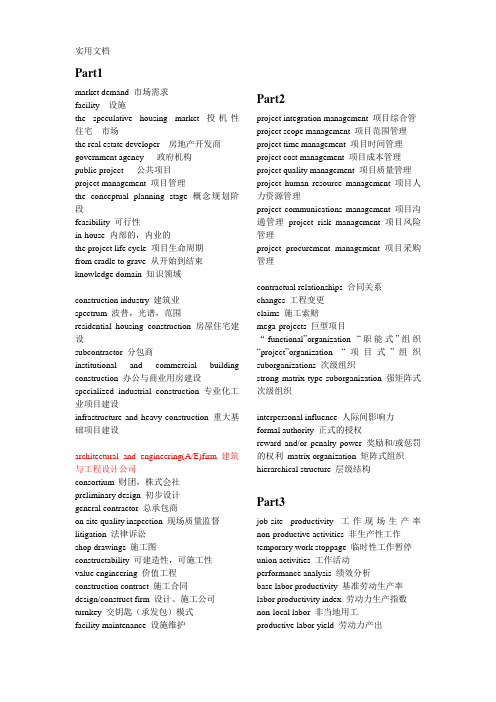
Part1market demand 市场需求facility 设施the speculative housing market 投机性住宅市场the real estate developer 房地产开发商government agency 政府机构public project 公共项目project management 项目管理the conceptual planning stage 概念规划阶段feasibility 可行性in-house 内部的,内业的the project life cycle 项目生命周期from cradle to grave 从开始到结束knowledge domain 知识领域construction industry 建筑业spectrum 波普,光谱,范围residential housing construction 房屋住宅建设subcontractor 分包商institutional and commercial building construction 办公与商业用房建设specialized industrial construction 专业化工业项目建设infrastructure and heavy construction 重大基础项目建设architectural and engineering(A/E)firm 建筑与工程设计公司consortium 财团,株式会社preliminary design 初步设计general contractor 总承包商on site quality inspection 现场质量监督litigation 法律诉讼shop drawings 施工图constructability 可建造性,可施工性value engineering 价值工程construction contract 施工合同design/construct firm 设计、施工公司turnkey 交钥匙(承发包)模式facility maintenance 设施维护Part2project integration management 项目综合管project scope management 项目范围管理project time management 项目时间管理project cost management 项目成本管理project quality management 项目质量管理project human resource management 项目人力资源管理project communications management 项目沟通管理project risk management 项目风险管理project procurement management 项目采购管理contractual relationships 合同关系changes 工程变更claims 施工索赔mega-projects 巨型项目“functional”organization “职能式”组织“project”organization “项目式”组织suborganizations 次级组织strong matrix-type suborganization 强矩阵式次级组织interpersonal influence 人际间影响力formal authority 正式的授权reward and/or penalty power 奖励和/或惩罚的权利matrix organization 矩阵式组织hierarchical structure 层级结构Part3job-site productivity 工作现场生产率non-productive activities 非生产性工作temporary work stoppage 临时性工作暂停union activities 工作活动performance analysis 绩效分析base labor productivity 基准劳动生产率labor productivity index 劳动力生产指数non-local labor 非当地用工productive labor yield 劳动力产出requisitions 询价purchase orders 订购单subcontracts 分包合同shipping and receiving documents 装船与接收文件invoices 发票bulk materials 大众材料standard off-the-shelf materials 现货材料fabricated members or units 预制构件或单元semi-processed state 半成品状态pre-processed 预加工的pressure vessels 压力容器field assembly 现场装配skilled craftsmen 熟练技工crawler mounting 履带式底盘claim shell 抓铲挖土机`dragline 拉铲挖土机backhoe 反铲挖土机shovel 正铲挖土机bulldozer 推土机rotary-percussion drills 旋转冲击钻bituminous 沥青Part4economic evaluation 经济评价the planning horizon 规划期cash flow profile 现金流量图minimum attractive rate of return(MARR) 最低收益率sensitivity or uncertainty analysis 敏感性或不确定性分析annual benefit 年收益annual cost 年费用net annual cash flow 年净现金流量opportunity cost 机会成本social rate of discount 社会贴现率profit measure利润指标值private corporations 私营股份制公司public agencies 公共机构net future value(NFV) /净终值net present value(NPV) 净现值equivalent uniform annual net value (NUV)等额净年值capital recovery factor 资金回收因子benefit-cost ratio(BCR) 收益-费用比profitability index 盈利指数saving-to-investment ratio(SIR) 存款投资比率absolute numerical measure 绝对指数internal rate of return(IRR) 内部收益率marginal efficiency of capital 边际资本收益return on investment(ROI) 投资收益payback period(PBP) 投资回收期profit maximization利润最大化public sector 公共领域basic principle 基本原理nonnegative 非负的budget constraint 预算限制incremental analysis 追加分析internal rate of return method 内部收益率法Part5Word Bank-financed projects 世界银行融资贷款项目foreign bidders 海外投标人civil works 土木工程I nternational Competitive Bidding(ICB) 竞争性国际招标Limited International Bidding 有限国际招标National Competitive Bidding 国内竞争性招标International Shopping 国际订购Direct Contracting 直接签约General Procurement Notice 通用采购公告prequalification 资格预审bidding documents 招标文件domestic contractors 国内承包商instructions to bidders 投标人须知conditions of contract 合同条件specifications of drawings 技术规范与图纸bill of quantities 工程量清单payment terms 支付条件minutes of the conference 会议纪要pre-bid conferences 标前会议site visits 现场踏勘substantially responsive 实质性响应the lowest evaluated cost 经评审的最低造价Part6the sealed bids 密封的投标报价construction company 建筑公司marketing strategy 市场营销策略long-term goals 长期目标client relationships 客户关系short-term goal 短期目标direct costs estimate 直接费估算mark-up 涨价溢价company or head office overheads 公司或总部管理费unrealistic bids 不切实际的报价owner-contractor agreement 业主与承包商之间订立的合同standard form of agreement 标准合同形式American Institute of Architects(AIA) 美国建筑师协会bonus and penalty clauses 奖励与惩罚条款lump-sum agreement 总价合同changer order 变更单written authorization 书面授权unit-price agreement 单价合同quantity takeoff 工程量清单cost-plus-fee agreements 成本加酬金合同equity partners 股权伙伴rental rates 出租比例percentage fee 百分百酬金合同fixed fee 固定酬金合同changes 工程变更contract award 合同授予changes clause 变更条款publicly financed project 公共融资项目extra work 附加工作the prime contractor 主承包商Part7the International Federation of Consulting Engineering 国际咨询师联合会the FIDIC Conditions of Contract for Constructions FIDIC施工合同条件the General Conditions (FIDIC)通用条件the Particular Conditions (FIDIC)专业条件the Appendix to Tender (FIDIC)投标附录arbitration 仲裁,裁决Dispute Adjudication Board(DBA)争议仲裁委员会Conditions of Contract for Works of Civil Engineering Construction 土木工程施工合同条件Conditions of Contract for Electrical and Mechanical Work 机电安装工程合同条件Conditions of Contract for Design-Build and Turnkey设计-建造于交钥匙合同条件Client/Consultant Model Services Agreement 客户/咨询师服务协议Conditions of Subcontract for Works of Civil Engineering Construction 土木工程分包合同条件Guides to the Use of the Different FIDIC Conditions of Contract 各种FIDIC合同条件应用指南Amicable Settlement of Construction Disputes 施工争端友好解决方式Insurance of Large Civil Engineering Projects 大型土木工程保险The Conditions of Contract for Plant and Design-Build (FIDIC)安装与设计-建造合同The Conditions of Contract for EPC/Turnkey Projects (FIDIC)EPC/交钥匙项目合同条件The Short Form of Contract (FIDIC)简短格式合同The Form of Contract for Dredging and Reclamation Works (FIDIC)疏浚与防洪工程合同格式priced contract with activity schedule 总价合同priced contract with bill of quantities 单价合同target contract with activity schedule 目标总价合同target contract with bill of quantities 目标单价合同cost reimbursable contract 成本补偿合同performance bond 履约保函parent company guarantee 母公司担保advance payment 预付款retention (工程)留置权bonus for early completion 工期提前奖delays damages 误期损害surety 担保financial loan 商业贷款insurance policy 保险政策in breach of contract 合同违约bid bond 投标担保justification (正当的)理由labor and material bond 劳动力与原材料担保lien bond 留置权担保comprehensive general liability insurance 综合责任险professional liability insurance职业责任险workers’compensation insurance 工人补偿险builder’s risk fire insurance 施工方火灾险Part8construction planning 施工计划the choice of technology 施工技术的选择the definition of work tasks 工作任务的定义the estimation of the required resources and durations for individual tasks 所需资源和各项工作持续时间的估算reasoning backward 逆向推理normative problem 规范性问题cost control 成本控制schedule control 进度控制critical path scheduling procedures 关键线路进度控制程序job shop scheduling procedures 工作现场进度控制程序work breakdown 工作分解manufacturing terminology加工制造业术语resource allocations 资源分配fore-runner 先行者laborious and tedious process 复杂和枯燥的过程general models 通用模型databases and information systems 数据库和信息系统the storage and recall of the activities工作活动的存储于记忆manpower 人力,劳动力the duration of the activity 工作活动的持续时间placing concrete on site 现场浇筑混凝土placing forms 支设模板installing reinforcing steel 绑扎钢筋pouring concrete 浇筑混凝土finishing the concrete 混凝土养护removing forms 模板拆除position forms on the cleaning station 在清理场所码放的模板hierarchical structure 层级结构work breakdown structure 工作结构分解precedence relations 先导顺序关系structural integrity结构整体性design drawings 设计图纸milestone events 里程碑事件lag 时间间隔computer based simulation 基于计算机的模拟excavation equipment 开挖机械\Part9critical path method(CPM) 关键路线发predecessor/successor activities先导/后续工作resource constraint 资源约束artificial precedence constraint 人为先导关系约束activity-branch network 双代号网络图dummy activity 虚工作earliest time schedule 最早时间进度latest time schedule 最迟时间进度float 时差,机动时间maneuvering room 可调整的余地free float 自由时差independent float 独立时差total float 总时差inter-relationships 相互关系graphical presentations of project schedules 项目进度的图形表达network diagrams 网络图time-scaled network 时标网络bar or Gantt chart 横道或甘特图horizontal axis 横轴,横坐标vertical axis 纵轴,纵坐标S-curves S型曲线resource graphs 资源图uncertainty associated with the actual durations与实际持续时间相关的不确定性regulatory approval 行政许可adverse weather 不利的天气contingency allowance 应急准备probabilistic perspective概率的角度independent random variables 相互独立的随机变量random fluctuations 随机波动positive correlations正相关over-optimistic 过于乐观的Part10e-construction 工程返工personal injuries 人身伤害conformance 遵守,服从re-evaluation of design decisions设计决策的重要评估tunneling methods 隧道开掘方法actual site conditions 现场的实际状况roadway rehabilitation 公路路面返修quality assurance 质量保证n-site inspections 现场监督检查US Occupational Safety and Health Administration(OSHA)美国职业安全与健康署violation of existing standard 违反现行规范标准employee participation in quality control 质量控制的员工参与statistical methods 统计方法batches of materials 材料批implicit assumption 隐含的假设total quality control 全面质量控制zero defects goal 零缺陷目标quality circles 质量环“optimum”proportion “最佳”的比例non-destructive techniques 非破坏性技术x-ray inspection of welds 焊接的X光检测exhaustive or 100% testing 全数或100%检测lot 母体,总体sampling by attributes 特征抽样sampling by variables 变量抽样direct costs 直接成本indirect costs 间接成本construction accidents 工程事故insurance premiums 保险赔偿unsecured railings 未经保护的围栏on-board electronics面板电子元器件asbestosis 矽肺,石棉肺sewer line 排污管道four lane street 四车道道路Part11construction yard and warehouse management information 施工仓储管理信息concrete pumps 混凝土泵warehouse clerks 仓储管理员daily rental charge 日租金tedious manual task 繁琐的手工作业application programs 应用程序duplicate 复制verbal description 文字描述warehouse inventory database 仓储清单数据库relational data model 关系数据模型data dictionary 数据字典numerical code 数据编码redundancy 冗余aggregate 集料,骨料external models of the information 外部信息模型algebraic theory 代数理论projection 映射advantages of distributed processing 分散式处理的优点dynamic changes in information needs 信息需求的动态变化untidy information 凌乱的信息information flow 信息流preprocessor system 预处理系统independent systems 独立系统geometric information 图形信息。
工程管理专业英语(6)
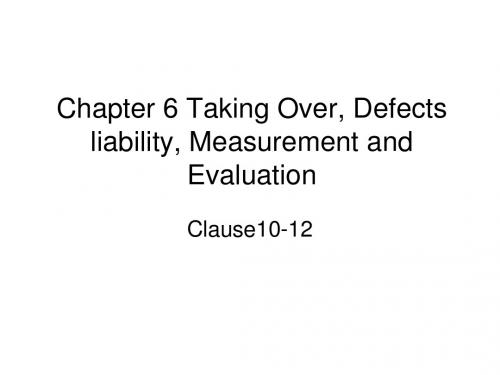
6.2 Defects liability
Completion of Outstanding Work and Remedying Defects[11.1]
• In order that the Works and Contractor's Documents, and each Section, shall be in the condition required by the Contract (fair wear and tear excepted) by the expiry date of the relevant Defects Notification Period or as soon as practicable thereafter, the Contractor shall: • in order that • be in the condition:有条件 • fair wear and tear:合理折旧,合理磨损
• When shall the Employer take over the Works? • How to apply for a Taking-Over Certificate? • What shall the Engineer do after receiving the Contractor’s application?
• (a) complete any work which is outstanding on the date stated in a Taking-Over Certificate, within such reasonable time as is instructed by the Engineer, and • (b) execute all work required to remedy defects or damage, as may be notified by(or on behalf of) the Employer on or before the expiry date of the Defects Notification Period for the Works or Section (as the case may be). • If a defect appears or damage occurs, the Contractor shall be notified accordingly, by (or on behalf of) the Employer.
工程管理专业英语

《工程管理专业英语》教学大纲开课学院:建筑工程学院Begin College:Construction Engineering College适用专业:工程管理Applicable to Professional:Engineering Management课程编号:Course Number:课程英文名称:Engineering ManagementEnglish Course Title:Engineering Management课程性质:学科基础课Course property:Discipline Basic Courses课程总课时:32Course Total Class:32学分:2Credit:2课程教学目标与基本要求:通过本课程的学习,使学生了解土木工程专业的培养目标、行业发展、主要的科学问题和解决的方法、课程之间的联系、专业学习的特点、毕业后的去向等情况。
能够为学生选修课程和将来的工作提供参考。
The teaching goal and the basic requirements:Through learning of this course, make students understand the civil engineering professional training target, industry development, the main scientific problems and the solution method, the connection between the course and the characteristics of professional learning, go after graduation, and so on and so forth.Courses for students and working to provide the reference for the future.教学内容Content of courses 教学要求Teaching requirement教学模式Modelteaching课时分配(建议)Teachinghours第一部分工程概述1.工程的概念2.工程的作用3.我国古代工程4.我国现代工程The first part Project overview1.The concept of the engineering;2.The role of engineering;3. Ancient China engineering ;4.Modern engineering in our country. 了解工程的概念;了解工程的作用;了解我国古代工程。
工程管理专业英语

目录Unit One About Engineering Economy第一单元关于工程经济Unit Two The Principles of Engineering Economy第二单元工程经济原理Unit Three Cost Concept第三单元成本概念Unit Four Time Value of Money第四单元金钱的时间价值Unit Five The Basic Methods of Engineering Economy 第五单元工程经济的基本方法Unit Six The Definition of a “Project”第六单元项目的定义Unit Seven Why Project Management?第七单元为什么要对项目进行管理?Unit Eight The Project Life Cycle第八单元项目的寿命周期Unit Nine The Project Manager第九单元项目经理Unit Ten Project Planning第十单元制订项目计划Unit Eleven Initial Project Coordination第十一单元开始的项目协调Unit Twelve Budgeting and Cost Estimation第十二单元预算和成本估算Unit Thirteen The Monitoring System of Project第十三单元项目监测系统Unit Fourteen Project Control第十四单元项目控制Unit Fifteen Conditions of Contract for Construction(Excerpts)第十五单元施工合同条件(节选)Unit One About Engineering EconomyEngineering economy——what is it, and why is it important? The initial reaction of many engineering students to these questions is “Money matters will be handled by someone else. It is not something I need to worry about.” In reality, any engineering project must be not only physically realizable, but also economically affordable. For example, a child's tricycle could be built with an aluminum frame or a composite frame. Some may argue that because the composite frame will be stronger and lighter, it is a better choice. However, there is not much of a market for thousand dollar tricycles! One might suggest that this argument is ridiculously simplistic and that common sense would dictate choosing aluminum for the framing material. Although the scenario is an exaggeration, it reinforces the idea that the economic factors of a design weigh heavily in the design process, and that engineering economy is an integral part of that process, regardless of the engineering discipline. Engineering, without economy, makes no sense at all.In broad terms, for an engineering design to be successful, it must be technically sound and produce benefits. These benefits must exceed the costs associated with the design in order for the design to enhance net value. The field of engineering economy is concerned with the systematic evaluation of the benefits and costs of projects involving engineering design and analysis. In other words, engineering economy quantifies the benefits and costs associated with engineering projects to determine whether they make (or save) enough money to warrant their capital investments. Thus, engineering economy requires the application of engineering design and analysis principles to provide goods and services that satisfy the consumer at an affordable cost. As we shall see, engineering economy is as relevant to the design engineer who considers material selection as it is to the chief executive officer whoapproves capital expenditures for new ventures.The technological and social environments in which we live continue to change at a rapid rate. In recent decades, advances in science and engineering have made space travel possible, transformed our transportation systems, revolutionized the practice of medicine, and miniaturized electronic circuits so that a computer can be placed on a semiconductor chip. The list of such achievements seems almost endless. In your science and engineering courses, you will learn about some of the physical laws that underlie these accomplishments.The utilization of scientific and engineering knowledge for our benefit is achieved through the design of things we use, such as machines, structures, products, and services. However, these achievements don't occur without a price, monetary or otherwise. Therefore, the purpose of this book is to develop and illustrate the principles and methodology required to answer the basic economic question of any design: Do its benefits exceed its costs?The Accreditation Board for Engineering and Technology states that engineering “is the profession in which a knowledge of the mathematical and natural sciences gained by study, experience, and practice is applied with judgment to develop ways to utilize, economically, the materials and forces of nature for the benefit of mankind.”*In this definition, the economic aspects of engineering are emphasized, as well as the physical aspects. Clearly, it is essential that the economic part of engineering practice be accomplished well.Therefore,engineering economy is the dollars-and-cents side of the decisions that engineers make or recommend as they work to position a firm to be profitable in a highly competitive marketplace.Inherent to these decisions are trade-offs among different types of costs and the performance(response time,safety, weight, reliability, etc.) provided by the proposed design or problem solution.The mission of engineering economy is to balance thesetrade-offs in the most economical manner. For instance, if an engineer at Ford Motor Company invents a new transmission lubricant that increases fuel mileage by 10% and extend s the life of the transmission by 30,000 miles,how much can the company afford to spend to implement this invention? Engineering economy can provide an answer.A few more of the myriad situations in which engineering economy plays a cruclal role come to mind:1. Choosing the best design for a high-efficiency gas furnace.2. Selecting the most suitable robot for a welding operation on an automotive assembly line.3. Making a recommendation about whether jet airplanes for an overnight delivery service should be purchased or leased.4. Determining the optimal staffing plan for a computer help desk.From these illustrations,it should be obvious that engineering economy includes significant technical considerations.Thus,engineering economy involves technical analysis with emphasis on the economic aspects, and has the objective of assisting decisions.This is true whether the decision maker is an engineer interactively analyzing alternatives at a computer-aided design workstation or the Chief Executive Officer(CEO)considering a new project.A n engineer who is unprepared to excel at engineering economy is not properly equipped for,his or her job.Cost considerations and comparisons are fundamental aspects of engineering practice.This basic point was emphasized in Section 1.1. However, the development of engineering economy methodology, which is now used in nearly all engineering work,is relatively recent.This does not mean that,historically, costs were usually overlooked in engineering decisions. However, the perspective that ultimate economy is a primary concern to the engineer and the availability of sound techniques to address this concern differentiate this aspect of modern engineering practicefrom that of the past.A pioneer in the field was Arthur M.Wellington, a civil engineer, who in the latter part of the nineteenth century specifically addressed the role of economic analysis in engineering projects. His particular area of interest was railroad building in the United States.This early work was followed by other contributions in which the emphasis was on techniques that depended primarily on financial and actuarial mathematics.In 1930. Eugene Grant published the first edition of his textbook.+ This was a milestone in the development of engineering economy as we know it today. He placed emphasis on developing an economic point of view in engineering,and(as he stated in the preface) “this point of view involves a realization that quite as definite a body of principles governs the economic aspects of an engineering decision as governs its physical aspects.” In 1942,Woods and DeGarmo wrote the first edition of this book,later titled Engineering Economy.Unit Two The Principles of Engineering EconomyThe development, study, and application of any discipline must begin with a basic foundation.We define the foundation for engineering economy to be a set of principles,or fundamental concepts,that provide a comprehensive doctrine for developing the methodology, These principles will be mastered by students as they progress through this book. However, in engineering economic analysis, experience has shown that most errors can be traced to some violation of or lack of adherence to the basic principles.Once aproblem or need has been clearly defined, the foundation of the discipline can be discussed in terms of seven principles.PRINCIPLE1-DEVELOP THE ALTERNATIVES:The choice(decision) is among alternatives. The alternatives need to be identified and then defined for subsequent analysisA decision situation involves making a choice among two or more alternatives. Developing and defining the alternatives for detailed evaluation is important because of the resulting impact on the quality of the decision.Engineers and managers should place a high priority on this responsibility.Creativity and innovation are essential to the process.One alternative that may be feasible in a decision situation is making no change to the current operation or set of conditions(i.e., doing nothing). If you judge this option feasible,make sure it is considered in the analysis. However, do not focus on the status quo to the detriment of innovative or necessary change.PRINCIPLE2-FOCUS ON THE DIFFERENCES:Only the differences in expected future outcomes among the alternatives are relevant to their comparison and should be considered in the decision.If all prospective outcomes of the feasible alternatives were exactly the same,there would be no basis or need for comparison.We would be indifferent among the alternatives and could make a decision using a random selection.Obviously, only the differences in the future outcomes of the alternatives are important.Outcomes that are common to all alternatives can be disregarded in the comparison and decision.For example,if your feasible housing alternatives were two residences with the same purchase(or rental)price,price would be inconsequential to your final choice.Instead,the decision would depend on other factors, such as location and annual operating and maintenance expenses. This example illustrates,in a simple way, Principle 2,which emphasizes the basic purpose of an engineeringeconomic analysis:to recommend a future course of action based on the differences among feasible alternatives.PRINCIPLE 3-USE A CONSISTENT VIEWPOINT:The prospective outcomes of the alternatives, economic and other, should be consistently developed from a defined viewpoint (perspective).The perspective of the decision maker, which is often that of the owners of the firm,would normally be used.However, it is important that the viewpoint for the particular decision be first defined and then used consistently in the description analysis,and comparison of the alternatives.As an example,consider a public organization operating for the purpose of developing a river basin,including the generation and wholesale distribution of electricity from dams on the river system.A program is being planned to upgrade and increase the capacity of the power generators at two sites. What perspective should be used in defining the technical alternatives for the program? The “owners of the firm” in this example means the segment of the public that will pay the cost of the program and their viewpoint should be adopted in this situation.Now let us look at an example where the viewpoint may not be that of the owners of the firm.Suppose that the company in this example is a private firm and that the problem deals with providing a flexible benefits package for the employees. Also, assume that the feasible alternatives for operating the plan all have the same future costs to the company.The alternatives,however, have differences from the perspective of the employees,and their satisfaction is an important decision criterion. The viewpoint for this analysis and decision should be that of the employees of the company as a group, and the feasible alternatives should be defined from their perspective.PRINCIPLE 4-USE A COMMON UNIT OF MEASURE:Using a common unit of measurement to enumerate asmany of the prospective outcomes as possible will simplify the analysis and comparison of the alternatives.It is desirable to make as many prospective outcomes as possible commensurable (directly comparable).For economic consequences,a monetary unit such as dollars is the common measure.You should also try to translate other outcomes(which do not initially appear to be economic) into the monetary unit.This translation,of course, will not be feasible with some of the outcomes, but the additional effort toward this goal will enhance commensurabilitv and make the subsequent analysis and comparison of alternatives easier.What should you do with the outcomes that are not economic(i.e., the expected consequences that cannot be translated (and estimated) using the monetary unit)? First, if possible, quantify the expected future results using an appropriate unit of measurement for each outcome.If this is not feasible for one or more outcomes,describe these consequences explicitly so that the information is useful to the decision maker in the comparison of the alternatives.PRINCIPLE 5-CONSIDER ALL RELEV ANT CRITERIASelection of a preferred alternative (decision making) requires the use of a criterion (or several criteria). The decision process should consider both the outcomes enumerated in the monetary unit and those expressed in some other unit of measurement or made explicit in a descriptive manner.The decision maker will normally select the alternative that will best serve the long-term interests of the owners of the organization. In engineering economic analysis, the primary criterion relates to the long-term financial interests of the owners. This is based on the assumption that available capital will be allocated to provide maximum monetary return to the owners. Often, though, there are other organizational objectives you would like to achieve with your decision, and these should be considered and given weight in the selection of an alternative. These nonmonetarv attributes andmultiple objectives become the basis for additional criteria in the decision-making process.PRINCIPLE6-MAKE UNCERTAINTY EXPLICIT:Uncertainty is inherent in projecting (or estimating) the future outcomes of the alternatives and should be recognized in their analysis and comparison.The analysis of the alternatives involves projecting or estimating the future consequences associated with each of them.The magnitude and the impact of future outcomes of any course of action are uncertain.Even if the alternative involves no change from current operations, the probability is high that today‟s estimates of, for example,future cash receipts and expenses will not be what eventually occurs. Thus, dealing with uncertainty is an important aspect of engineering economic analysis and is the subject of Chapters 10 and 13.PRINCIPLE 7- REVISIT YOUR DECISIONS:Improved decision making results from an adaptive process, to the extent practicable, the initial projected outcomes of the selected alternative should be subsequently compared with actual results achieved.A good decision-making process can result in a decision that has an undesirable outcome. Other decisions, even though relatively successful,will have results significantly different from the initial estimates of the consequences. Learning from and adapting based on our experience are essential and are indicators of a good organization.The evaluation of results versus the initial estimate of outcomes for the selected alternative is often considered impracticable or not worth the effort. Too often, no feedback to the decision-making process occurs. Organizational discipline is needed to ensure tha t implemented decisions are routinely postevaluated and that the results used to improve future analyses of alternatives and the quality of decision making.The percentage of important decisions inan organization that are not postevaluated should be small.For example,a common mistake made in the comparison of alternatives is the failure to examine adequately the impact of uncertainty in the estimates for selected factors on the decision.Only postevaluations will highlight this type of weakness in the engineering economy studies being done in an organization.Unit Three Cost Concept3.1 Fixed, Variable, and Incremental CostsFixed costs are those unaffected by changes in activity level over a feasible range of operations for the capacity or capability available. Typical fixed costs include insurance and taxes on facilities, general management and administrative salaries, license fees, and interest costs on borrowed capital.Of course, any cost is subject to change, but fixed costs tend to remain constant over a specific range of operating conditions. When large changes in usage of resources occur, or when plant expansion or shutdown is involved, fixed costs will be affected.Variable costs are those associated with an operation that vary in total with the quantity of output or other measures of activity level. If you were making an engineering economic analysis of a proposed change to an existing operation, the variable costs would be the primary part of the prospective differences between the present andchanged operations as long as the range of activities is not significantly changed. For example, the costs of material and labor used in a product or service are variable costs, because they vary in total with the number of output units, even though the costs per unit stay the same.An incremental cost (or incremental revenue) is the additional cost (or revenue) that results from increasing the output of a system by one (or more) units. Incremental cost is often associated with “go-no go” decisions that involve a limited change in output or activity level.③For instance, the incremental cost per mile for driving an automobile may be. $0.27, but this cost depends on considerations such as total mileage driven during the year (normal operating range), mileage expected for the next major trip, and the age of the automobile. Also, it is common to read of the “incremental cost of producing a barrel of oil” and “incremental cost to the state for educating a student.” As these examples indicate, the incremental cost (or revenue) is often quite difficult to determine in practice.3.2 Recurring and Nonrecurring CostsThese two general cost terms are often used to describe various types of expenditures. Recurring costs are those that are repetitive and occur when an organization produces similar goods or services on a continuing basis. Variable costs are also recurring costs, because they repeat with each unit of output. But recurring costs are not limited to variable costs. A fixed cost that is paid on a repeatable basis is a recurring cost. For example, in an organization providing architectural and engineering services, office space rental, which is a fixed cost, is also a recurring cost.Nonrecurring costs, then, are those which are not repetitive, even though the total expenditure may be cumulative over a relatively short period of time. Typically, nonrecurring costs involve developing or establishing a capability or capacity to operate. For example, the purchase cost for real estate upon which a plant will bebuilt is a nonrecurring cost, as is the cost of constructing the plant itself.3.3 Direct, Indirect, and Standard CostsThese frequently encountered cost terms involve most of the cost elements that also fit into the previous overlapping categories of fixed and variable costs, and recurring and nonrecurring costs. Direct costs are costs that can be reasonably measured and allocated to a specific output or work activity. The labor and material costs directly associated with a product, service, or construction activity are direct costs. For example, the materials needed to make a pair of scissors would be a direct cost.Indirect costs are costs that are difficult to attribute or allocate to a specific output or work activity. The term normally refers to types of costs that would involve too much effort to allocate directly to a specific output. In this usage, they are costs allocated through a selected formula (such as, proportional to direct labor hours, direct labor dollars, or direct material dollars) to the outputs or work activities. For example, the costs of common tools, general supplies, and equipment maintenance in a plant are treated as indirect costs.Overhead consists of plant operating costs that are not direct labor or direct material costs. In this book, the terms indirect costs, overhead, and burden are used interchangeably. Examples of overhead include electricity, general repairs, property taxes, and supervision. Administrative and selling expenses are usually added to direct costs and overhead costs to arrive at a unit selling price for a product or service. (Appendix A provides a more detailed discussion of cost accounting principles.)Various methods are used to allocate overhead costs among products, services, and activities. The most commonly used methods involve allocation in proportion to direct labor costs, direct labor hours, direct materials costs, the sum of direct labor and direct materials costs (referred to as prime cost in a manufacturing operation), or machine hours. In each of these methods, it isnecessary to know what the total overhead costs have been or are estimated to be for a time period (typically a year) to allocate them to the production (or service delivery) outputs.Standard costs are representative costs per unit of output that are established in advance of actual production or service delivery. They are developed from anticipated direct labor hours, materials, and overhead categories (with their established costs per unit). Because total overhead costs are associated with a certain level of production, this is an important condition that should be remembered when dealing with standard cost data (for example, see Section 2.5.3). Standard costs play an important role in cost control and other management functions. Some typical uses are the following:1. Estimating future manufacturing costs.2. Measuring operating performance by comparing actual cost per unit with the standard unit cost.3. Preparing bids on products or services requested by customers.4. Establishing the value of work in process and finished inventories.3.4 Cash Cost versus Book CostA cost that involves payment of cash is called a cash cost (and results in a cash flow) to distinguish it from one that does not involve a cash transaction and is reflected in the accounting system as a noncash cost. This noncash cost is often referred to as a book cost. Cash costs are estimated from the perspective established for the analysis (Principle 3, Section 1.3) and are the future expenses incurred for the alternatives being analyzed. Book costs are costs that do not involve cash payments, but rather represent the recovery of past expenditures over a fixed period of time. The most common example of book cost is the depreciation charged for the use of assets such as plant and equipment. In engineering economic analysis, only those costs that are cash flows or potential cash flows from the defined perspective for the analysis need to be considered.Depreciation, for example, is not a cash flow and is important in an analysis only because it affects income taxes, which are cash flows. We discuss the topics of depreciation and income taxes in Chapter 6.3.5 Sunk CostA sunk cost is one that has occurred in the past and has no relevance to estimates of future costs and revenues related to an alternative course of action. Thus, a sunk cost is common to all alternatives, is not part of the future (prospective) cash flows, and can be disregarded in an engineering economic analysis. For instance, sunk costs are nonrefundable cash outlays, such as earnest money on a house or money spent on a passport.We need to be able to recognize sunk costs and then handle them properly in an analysis. Specifically, we need to be alert for the possible existence of sunk costs in any situation that involves a past expenditure that cannot be recovered, or capital that has already been invested and cannot be retrieved.The concept of sunk cost is illustrated in the next simple example. Suppose that Joe College finds a motorcycle he likes and pays $40 as a down payment, which will be applied to the $1,300 purchase price, but which must be forfeited if he decides not to take the cycle. Over the weekend, Joe finds another motorcycle he considers equally desirable for a purchase price of $1,230. For the purpose of deciding which cycle to purchase, the $40 is a sunk cost and thus, would not enter into the decision, except that it lowers the remaining cost of the first cycle. The decision then is between paying $1,260 ($1,300~$40) for the first motorcycle versus $1,230 for the second motorcycle.In summary, sunk costs result from past decisions and therefore are irrelevant in the analysis and comparison of alternatives that affect the future. Even though it is sometimes emotionally difficult to do, sunk costs should be ignored, except possibly to the extent that their existence assists you to anticipate better what will happen in the future.3.6 Opportunity CostAn opportunity cost is incurred because of the use of limited resources, such that the opportunity to use those resources to monetary advantage in an alternative use is foregone. Thus, it is the cost of the best rejected (i.e., foregone) opportunity and is often hidden or implied.For example, suppose that a project involves the use of vacant warehouse space presently owned by a company. The cost for that space to the project should be the income or savings that possible alternative uses of the space may bring to the firm. In other words, the opportunity cost for the warehouse space should be the income derived from the best alternative use of the space. This may be more than or less than the average cost of that space obtained from the accounting records of the company.Consider also a student who could earn $20,000 for working during a year, but chooses instead to go to school for a year and spend $5,000 to do so. The opportunity cost of going to school for that year is $25,000:$5,000 cash outlay and $20,000 for income foregone. (This figure neglects the influence of income taxes and assumes that the student has no earning capability while in school.)3.7 Life-Cycle CostIn engineering practice, the term life-cycle cost is often encountered. This term refers to a summation of all the costs, both recurring and nonrecurring, related to a product, structure, system, or service during its life span, The life cycle is illustrated in Figure 2-2. The life cycle begins with identification of the economic need or want (the requirement) and ends with retirement and disposal activities. It is a time horizon that must be defined in the context of the specific situation-whether it is a highway bridge, a jet engine for commercial aircraft, or an automated flexible manufacturing cell for a factory. The end of the life cycle may be projected on a functional or an economic basis. For example, the amount of time that a structure or piece of equipment is able to perform economically maybe shorter than that permitted by its physical capability. Changes in the design efficiency of a boiler illustrate this situation. The old boiler may be able to produce the steam required, but not economically enough for the intended use.Unit Four Time Value of Money4.1 IntroductionThe term capital refers to wealth in the form of money or property that can be used to produce more wealth. The majority of engineering economy studies involve commitment of capital for extended periods of time, so the effect of time must be considered. In this regard, it is recognized that a dollar today is worth more than a dollar one or more years from now because of the interest (or profit) it can earn. Therefore, money has a time value.4.2 Why Consider Return to Capital?Capital in the form of money for the people, machines, materials, energy, and other things needed in the operation of an。
Unit 1 Types of construction project(工程管理专业英语)
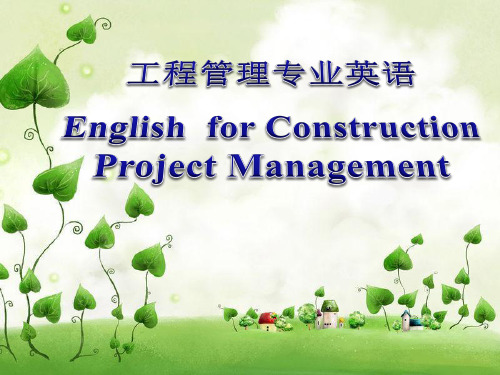
Exordium
Contents
Vocabulary
Key Structures
Questions
English for Construction Project Management
Unit One Types of Construction Project
……and typically all phase of the project are handled by the same firm on a negotiated designconstruct or “turnkey” contractual arrangement, with considerable overlap between design, procurement, and construction. 此外,(工业建筑)项目各阶段的工作一般依据设计建 造或交钥匙合同由同一家企业来承担,因而其设计、采 购与施工等各阶段工作之间存在相当大的工作联系。 “turnkey” contractual arrangement,交钥匙合同方式, 即工程项目建设的全过程,包括设计、采购、施工、运 行试验等都由同一家企业承包,最后它将一个随时可以 使用的工程交给合同另一方的方式。
虽然它们和住宅类建设一样,也是劳动力与材料 密集型,但此类项目范围更广,所包含的技术更复 杂。 句中的labor-and-materials-intensive 为 “劳动力与材料密集型”的意思。much larger 与 more complex 分别对应其前的the scope 与technology.
精炼厂,炼制厂
Vocabulary
high-rise
Key Structures
n
高楼,大厦;a 高层的
工程管理专业英语3
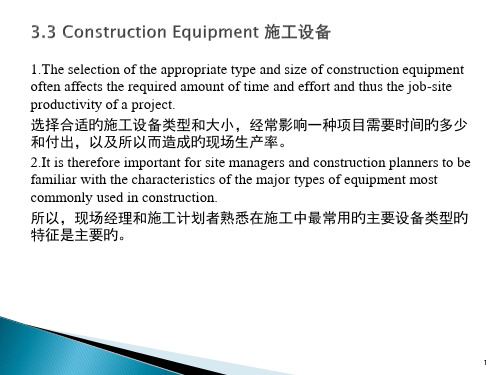
8
Compaction and Grading 压实和平整场地 19. The function of compaction equipment is to produce higher density in soil mechanically. 压实设备旳作用就是经过机械使土产生跟高旳密度。 20.The basic forces used in compaction are static weight, kneading, impact and vibration. 在压实过程中使用旳基本力是静重力、捏合力、冲击力和震 动力。 21. The degree of compaction that may be achieved depends on the properties of soil, its moisture content, the thickness of the soil layer for compaction and the method of compaction. 可能到达旳压实度取决于土质、土旳含水量、所压实土层旳 厚度以及压实旳措施。
26. The degree of difficulty depends on physical characteristics of the rock type to be excavated, such as grain size, planes of weakness, weathering, brittleness and hardness. 这项工作旳难以程度依赖于要开挖旳岩石类型旳物理性质。 例如粒径大小、软弱位面、风化度、脆度和硬度。
反铲挖土机
铲Байду номын сангаас/正铲
打桩机
6
工程管理专业英语unit

3
谈判英语的应用场景
谈判英语广泛应用于工程项目合作、国际贸易、 商务交流等领域,是工程管理专业人员必备的技 能之一。
04
Engineering Management Professional English Practice
Case Analysis
Case preparation
Provide background information and prepare necessary documents for students to understand the case.
Engineering Management Professional English Unit
contents
目录
• introduction • Fundamentals of English in
Engineering Management • Application of English in
Simulation monitoring
Monitor the progress of the simulation and provide guidance and assistance when needed.
ABCD
Simulation implementation
Provide necessary tools and resources for students to carry out the simulation.
English-written technical documents
and reports in the field of engineering
management.
Objective 4
工程管理专业英语-PPT课件

information its
of
interest
to
component
national
The activities of FIDIC
• Seminar: A meeting for an exchange of ideas • conference : a formal meeting of people with a shared interest • Training courses : the action of teaching • Bookshop:a shop where books are sold
2.Procedure of bid and tender
3.国际工程合同条 件
目前国际工程项目常用的合同条件主要有: • 国际咨询工程师联合会(FIDIC)编制的系列合同 条件; • 英国土木工程师学会编制的ICE合同,NEC合同; • 美国建筑师学会的AIA系列合同条件; • 英国皇家建筑师学会的JCT合同及亚洲地区使用的 各种合同条件。
FIDIC IS THE MOST COMMONLY USED CONDITIONS OF CONTRACT FOR INERNATIONAL CONSTRUCTION PROJECTS。 其合同条款齐全,内容完整、词语严谨,可操作 性强,适用范围广,是世界各国参与国际市场竞争 共同遵守的交易规则。 合同公正、合理、科学地确立了合同双方的责权 利关系,有利于合同双方公平高效地履行合同,有 利于提高工程的整体效益。
ership today numbers 75 Member Associations representing some 1 million professionals. CHINA joined FIDIC in 2019,10
